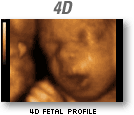Ultrasound Technology: |  |
General Electric, which traces its history to 1878 when Thomas Edison established the Edison Electric Light Company, has been responsible for enhancing the quality of human life in many ways.
It adds to that tradition with a new ultrasound device that allows doctors and parents to look inside the womb of a pregnant woman and see the image of a baby in "real-time 4D" rather than the more difficult to read traditional "2D" image.
GE is running a TV commercial that's more exciting to watch than most programs. It shows the face of a woman as she reacts to seeing her baby for the first time. We also see her husband, an unusual twist on TV. If this scene doesn't touch you in the deepest recesses of your heart, the device could determine whether you have a heart.
There's also a Web site where the commercial can be viewed (www.gemedicalsystems.com/rad/us/4d/index.html). Over the song, "The First Time Ever I Saw Your Face," an announcer says, "When you see your baby for the first time on the new GE 4D Ultrasound system, it really is a miracle."
A press release from GE touts the medical benefits expected to come from the device because doctors will be able to see the developing child more clearly, enabling them to better diagnose potential problems. But this device may have some unintended consequences in the cultural battle over the meaning and value of human life.
The clarity of the image resembles a high-quality photograph. Everyone who sees such a picture will find it extremely difficult to regard the image as anything but that of a baby; not a "fetus," not a "product of conception," not disembodied tissue. The hands move. So does the head. Does the baby's status change because the parents love him or her and want their child to be delivered safely so they can hold in their arms what the mother now holds in her womb? Or does the child inherit an intrinsic right to life separate from what politicians, lawyers, judges and even the woman herself might think?
This, of course, is the great debate. Which side we come down on has implications and applications not only for abortion, but in relation to end-of-life issues and in-between ones, like cloning.
In more than 30 years of speaking to pregnancy help centers, I've met hundreds of women who've had abortions. Virtually all have told me that if they'd seen a picture of their baby, they would have made a different choice. They've also told me that many abortion clinics turn sonogram machines in such a way that the mother is prevented from seeing her baby's image on the screen.
In an age when federal law mandates labels on cans, bottles and cars and truth-in-lending information at banks, why should women be denied information when it comes to a far more important choice about another human life? Few people regret choosing one car over another, or a can of string beans over a can of corn. But many women with whom I've spoken profoundly regret deciding to have an abortion and say their choice would have been different had they seen the person most directly affected by the procedure.
In a press release, GE quotes Michelle Tooms, a patient from Mansfield, Texas, who could see her baby on the GE 4D machine: "On other ultrasound systems, my doctor pointed to my baby's anatomy on the monitor and I couldn't understand what the doctor was trying to explain. With GE's 4D ultrasound, the quality was amazing. I even think I saw the baby smile. The images made me feel close to her." (italics mine).
GE publicity does not suggest the Ultrasound 4D be used in the war against abortion, yet it will be and should be. At $120,000, the machine is expensive, but every pregnancy help center should have one and the law should require every pregnant woman seeking an abortion to view this image of her baby. It might even make her smile and decide to bring another "good thing" to life.